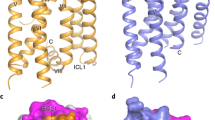Abstract
Receptor-induced binding of the stable GTP analogue, guanosine 5′-[γ-thio]triphosphate (GTP [γS]), to guanine nucleotide-binding regulatory proteins (G proteins) was measured in various permeabilized cells. In myeloid differentiated human leukemia (HL-60) cells, permeabilized with either digitonin, streptolysin O or Staphylococcus aureus α-toxin, binding of GTP [γS] induced by three distinct chemoattractant receptors was observed. The extent of receptor-stimulated GTP [γS] binding (maximally about 2-fold) was independent of the type of permeabilizing agent used. In human erythroleukemia cells permeabilized with digitonin, agonist activation of thrombin and neuropeptide Y receptors increased GTP [γS] binding by 1.8- and 1.5-fold, respectively. Finally, in adherently grown human embryonic kidney cells permeabilized with digitonin, activation of the stably expressed human muscarinic m3 receptor increased GTP[γS] binding by about 1.6-fold. In digitonin-permeabilized HL-60 cells, a quantitative analysis of formyl peptide receptors and interacting G proteins was performed. About 50,000 formyl peptide receptors per cell were detected. Agonist binding to these receptors was fully sensitive to regulation by guanine nucleotides and pertussis toxin. The number of high-affinity GTP [γS] binding sites, most likely representing heterotrimeric G proteins, was calculated to be about 670,000 per cell. Stimulation of formyl peptide receptors led to the activation of about 130,000 of high-affinity GTP [γS] binding sites, indicating a ratio of about three activated G proteins per one agonist-activated receptor.
Overall, this study indicates that receptor-stimulated GTP [γS] binding to G proteins in permeabilized cells is a sensitive and rapid method for analyzing receptor-G protein interactions, which can be applied to a variety of cultured cells and for various receptor systems.
Similar content being viewed by others
References
Ahnert-Hilger G, Mach W, Föhr KJ, Gratzl M (1989) Poration by α-toxin and streptolysin O: An approach to analyze intracellular processes. Methods Cell Biol 31:63–90
Birnbaumer L, Abramowitz J, Brown AM (1990) Receptor effector coupling by G proteins. Biochem Biophys Acta 1031:163–224
Boulay F, Tiff M, Brouchon L, Vignais P (1990) The human N-formylpeptide receptor. Characterization of two cDNA isolates and evidence for a new subfamily of G-protein-coupled receptors. Biochemistry 29:11123–11133
Chaplinski TJ, Niedel JE (1982) Cyclic nucleotide-induced maturation of human promyelotic leukemia cells. J Clin Invest 70:953–964
Feth F, Rascher W, Michel MC (1992) Neuropeptide Y (NPY) receptor in HEL cells: comparison of binding and functional parameters for full and partial agonists and a non-peptide antagonist. Br J Pharmacol 105:71–76
Gierschik P, Jakobs KH (1987) Receptor-mediated ADP-ribosylation of a phospholipase C-stimulating G protein. FEBS Lett 224:219–223
Gierschik P, Sidiropoulos D, Jakobs KH (1989a) Two distinct Gi-proteins mediate formyl peptide receptor signal transduction in human leukemia (HL-60) cells. J Biol Chem 264:21470–21473
Gierschik P, Steisslinger M, Sidiropoulos D, Herrmann E, Jakobs KH (1989b) Dual Mg2+ control of formyl peptide receptor-G protein interaction. Evidence that the low-agonist-affinity receptor interacts with and activates the G protein. Eur J Biochem 183:97–105
Gierschik P, Sidiropoulos D, Steisslinger M, Jakobs KH (1989c) Na+ regulation of formyl peptide receptor-mediated signal transduction in HL 60 cells. Evidence that the cation prevents activation of the G-protein by unoccupied receptors. Eur J Pharmacol 172:481–492
Gierschik P, Moghtader R, Straub C, Dieterich K, Jakobs KH (1991) Signal amplification in HL 60 granulocytes. Evidence that the chemotactic peptide receptor catalytically activates guanine-nucleotide-binding regulatory proteins in native plasma membranes. Eur J. Biochem 197:725–732
Gierschik P, Bouillon T, Jakobs KH (1994) Receptor-stimulated hydrolysis of guanosine 5′-triphosphate in membrane preparations. Methods Enzymol 237:13–26
Gilman AG (1987) G proteins: transducers of receptor generated signals. Annu Rev Biochem 56:615–649
Kikuchi A, Kozawa O, Kaibuchi K, Katada T, Ui M, Takai Y (1986) Direct evidence for involvement of a guanine nucleotide-binding protein in chemotactic peptide-stimulated formation of inositol bisphosphate and trisphosphate in differentiated human leukemic (HL-60) cells. Reconstitution with Gi or G0 of the plasma mem branes ADP-ribosylated by pertussis toxin. J Biol Chem 261: 11558–11562
Koo C, Lefkowitz RJ, Snyderman R (1982) The oligopeptide chemotactic factor receptor on human polymorphonuclear leukocyte membranes exists in two affinity states. Biochem Biophys Res Commun 106:442–449
McLeish KR, Gierschik P, Schepers T, Sidiropoulos D, Jakobs KH (1989) Evidence that activation of a common G-protein by receptors for leukotriene B4 and N-formylmethionyl-leucylphenylalanine in HL-60 cells occurs by different mechanisms. Biochem J 260:427–434
Peralta EG, Ashkenazi A, Winslow JW, Ramachandran J, Capon DJ (1988) Differential regulation of PI hydrolysis and adenylyl cyclase by muscarinic receptor subtypes. Nature 334: 434–437
Schepers TM, Brier ME, McLeish KR (1992) Quantitative and qualitative differences in guanine nucleotide binding protein activation by formyl peptide and leukotriene B4 receptors. J Biol Chem 267:159–165
Sklar LA, Bokoch GM, Button D, Smolen JE (1987) Regulation of ligand-receptor dynamics by guanine nucleotides: Real-time analysis of interconverting states for the neutrophil formyl peptide receptor. J Biol Chem 262:135–139
Snyderman R, Pike MC, Edge S, Lane B (1984) A chemoattractant receptor on macrophages exists in two affinity states regulated by guanine nucleotides. J Cell Biol 98:444–448
Stryer L, Bourne HR (1986) G proteins: a family of signal transducers. Annu Rev Cell Biol 2:391–419
Wieland T, Jakobs KH (1994) Measurement of receptor-stimulated guanosine 5′-O-[γ-thio]triphosphate binding by G proteins. Methods Enzymol 237:3–13
Wieland T, Gierschik P, Jakobs KH (1992a) G protein-mediated receptor-receptor interactions: Studies with chemotactic receptors in membranes of human leukemia (HL 60) cells. Naunyn-Schmiedeberg's Arch Pharmacol 346:475–481
Wieland T, Kreiss J, Gierschik P, Jakobs KH (1992b) Role of GDP in formyl-peptide receptor-induced activation of guanine-nucleotide-binding proteins in membranes of HL 60 cells. Eur J Biochem 205:1201–1206
Wright DG (1987) A role for guanine ribonucleotides in the regulation of myeloid cell maturation. Blood 69:334–337
Author information
Authors and Affiliations
Rights and permissions
About this article
Cite this article
Wieland, T., Liedel, K., Kaldenberg-Stasch, S. et al. Analysis of receptor-G protein interactions in permeabilized cells. Naunyn-Schmiedeberg's Arch Pharmacol 351, 329–336 (1995). https://doi.org/10.1007/BF00169072
Received:
Accepted:
Issue Date:
DOI: https://doi.org/10.1007/BF00169072




